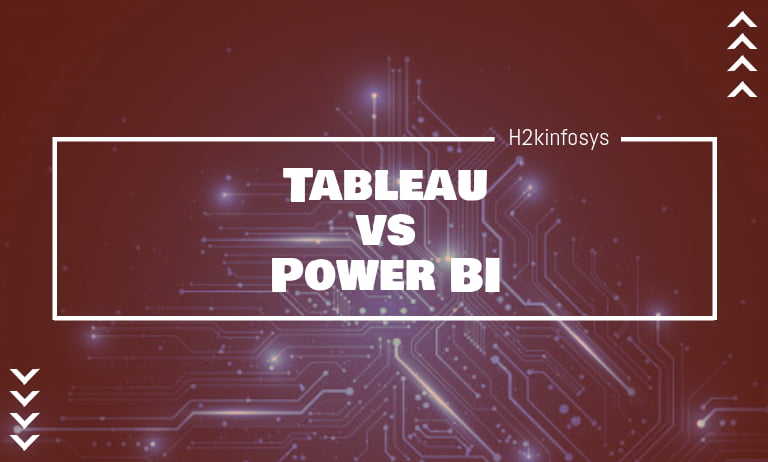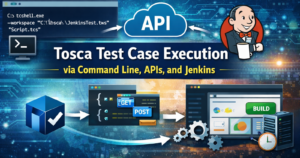Tableau vs Power BI: Tableau and Power BI both are excellent and most used visualization tools. Tableau has established as the market leader for data analytics and BI tools.
Power BI is the nearest competitor for the Tableau. Both of these visualization tools have their strengths and specialties, and each will be used in business as per requirements.
What is Tableau?
Tableau is a fast-growing visualization tool used in BI (Business Intelligence) Industry and discovery for all types of business and organization users. It simplifies the raw data into an easy and understandable format. Tableau contains a simple drag and drop features, and users can analyze critical data quickly using this feature.
Tableau allows embedding the dashboards into existing business applications such as SharePoint for quick analytics.
What is the Power BI?
Power BI is a cloud-based analytics tool and business intelligence (BI) platform. Power BI simplifies data sharing and evaluation for users by connecting to all of their data sources. Moreover, it offers scalable dashboards that make it easy for the users to choose various visualization as blueprints, and then drag and drop the data from the navigation into the visualization. It also contains a feature of Adhoc report generation, which helps in the analysis of the data.
Features of Tableau:
- Data blending is the important feature in Tableau, which is used when we want to combine related data from multiple data sources and analyzing it together in a single view and represent in the form of a graph.
- Real-Time Analysis makes the users enable to quickly understand and analyze the dynamic data when the Velocity is high, and real-time analysis of the data is complicated. Tableau can help extract valuable information from fast-moving data with interactive analytics.
- Data analysis is not an isolating task. That is why Tableau is built for collaboration. Team members can share data, make follow up queries, and forward the visualizations to others.
- Technical knowledge is not required.
- It provides a drag and drop feature.
- Filtering of data is allowed.
- Many types of charts and graphs can be easily created.
Features of Power BI:
- Real-time dashboards that help business owners to solve problems as they occur.
- It offers Power BI embedded azure service that allows applications to interact with Power BI.
- It contains a feature of Q&A, which allows users to ask questions using the natural language and getting answers in a specific graphical form.
- It also contains Help & Feedback buttons.
- Ad Hoc reporting and analysis.
Tableau Products:
The various products of Tableau are:
- Tableau Desktop: Tableau Desktop provides a rich feature set, and it allows you to code and customizes reports. You can create charts, reports, and blend them all to form a dashboard in Tableau Desktop. The dashboards and the workbooks created here can either be shared locally or publicly.
- Tableau Desktop Personal: The features of this product are similar to Tableau Desktop. The personal version keeps the workbook private and offers only limited access. The workbooks in the Personal version cannot be published online. Therefore, it should either be distributed offline or in Tableau Public.
- Tableau Desktop Professional: It is similar to Tableau Desktop. The only difference is that the work created in the Tableau Desktop Professional can be published online or in Tableau Server. In addition, there is full access to all sorts of datatype in this version.
- Tableau Public: This Tableau version is specially built for cost-effective users. Files saved in Tableau’s public cloud can be viewed and can be accessed by anyone. There is no privacy to the files that are saved to the cloud since anyone can download and access the files. This version is best for individuals who want to learn Tableau BI.
- Tableau Server: Tableau server shares the workbooks and visualizations that are created in the Tableau Desktop application across the complete organization. For sharing dashboards in the Tableau Server, you need to first publish your work in the Tableau Desktop. Once the work is uploaded to the server, it will be accessible only to the licensed users. However, it’s not necessary that the licensed users need to have the Tableau Server installed on their machine.
- Tableau Online: As the name suggests, this is an online sharing product of Tableau and its functionalities are same as Tableau Server, but the data that is stored on the servers hosted in the cloud are maintained by the Tableau group, and there is no storage limit on the data that can be published in the Tableau Online.
- Tableau Reader: Tableau Reader is free to use. This product allows you to view the workbooks and visualizations created using Tableau Desktop or Tableau Public. However, the security level is zero in Tableau Reader since anyone who gets the workbook can view it using Tableau Reader.
Power BI Products:
The various products of Power BI are:
- Power BI Desktop: The Power BI Desktop is the primary authoring and publishing tool for Power BI. Developers use this tool to create brand new models and reports from scratch.
- Power BI Service: Power BI service is an online Software as a Service (SaaS) where Power BI data models, reports, and dashboards are hosted on the cloud. Administration, sharing, and collaboration also happen in the cloud.
- Power BI Data Gateway: Power BI Data Gateway works as the bridge between the Power Bl Service and on-premise data sources like Direct Query, Import, Live Query. It is installed by the Bl Admin.
- Power BI Report Server: It can host paginated reports, mobile reports, and Power Bl Desktop reports. The users can modify Power Bl reports and other reports created by the development team.
- Power BI Mobile Apps: Power BI mobile app is available for iOS, Android, Windows users, and managed by Microsoft Intune. This tool allows you to view reports and dashboards on the Power Bl Service Report Server.
Tableau vs. Power BI:
The key differences between Tableau vs Power BI are:
| Tableau | Power BI |
| Tableau can easily handle a large amount of data with better performance. | Power BI can handle only a limited amount of data. |
| It has an excellent customer support and a large forum for discussions. | It has limited customer support on the free Power BI account. However, it gives faster customer support on paid accounts. |
| It still works best when there is a large amount of data in the cloud. | It does not work better with a large amount of data. |
| It is a little bit difficult. | It is very easy to learn. |
| Analysts and experienced users mostly use Tableau. | IT can be used by both naïve and experienced users. |
| It is suitable for medium and large organizations. | It is suitable for every small, medium, and large organizations. |
| It deploys MDX for dimensions and measures. | It uses DAX for calculating and measuring columns. |
| It can connect to numerous data sources. | It can connect with limited data sources. |
| Embedding reports is a challenge. | Embedding report is easy. |
Advantages of Tableau:
- Data Visualization: Tableau is a powerful data visualization tool, and it provides complex computation, data blending, and dashboards for creating beautiful data visualizations.
- Quickly Create Interactive Visualization: Users can easily create a very interactive visual by using drag and drop functionalities of Tableau.
- Comfortable in Implementation: Different types of visualization options are available in Tableau to enhance the user experience.
- Tableau can easily handle a large amount of data. A large amount of data can be used to create different types of visualization without disturbing the performance of the initial dashboards. Also, there is another option in Tableau in which the user can make live to connect different data sources such as SQL, etc.
- Use of other Scripting Language in Tableau: To avoid the performance issues and do complex table calculations in Tableau, users can also include Python or R. Using Python Script, the user can easily remove the load of the software by performing data cleansing tasks.
- Mobile Support and Responsive Dashboard: Tableau Dashboard contains a reporting feature that allows you to customize a dashboard specifically for devices such as a mobile or laptops. Tableau automatically understands which device is used by the user to view the reports, and so it makes adjustments to ensure that an accurate report is delivered to the appropriate device.
Advantages of Power BI:
- No Memory and Speed Constraints: For shifting an existing BI system into a powerful cloud environment embedded with Power BI eliminates memory. Speed constraints also ensure that data is quickly retrievable and analyzed.
- No Specialized Technical Support is required: The Power BI provides a quick inquiry and analysis without the need for specialized technical support. It also provides a powerful natural language interface and the use of intuitive graphical designer tools.
- Simple to Use: Power BI is very simple to use, and users can easily find it only on behalf of the short learning curve.
- The Power BI product is updated every month with new functions and features.
- Rich, personalized dashboard: The important feature of Power BI is the information dashboards that are customized to meet the exact need of an organization. You can easily embed the dashboards and BI reports in the applications to provide a good user experience.
Disadvantages of Tableau:
- Scheduling of Reports: Tableau does not provide the feature of automatic scheduling of reports. That is why there is always some manual effort required whenever the user needs to update the data in the back end.
- No Custom Visual Imports: Using other tools such as Power BI, a developer can create custom visuals that can be easily imported in Tableau.
- Static and Single Value Parameter: Tableau parameters are static, and they always use a single value as a parameter. Whenever the data is changed, these parameters also need to be updated manually every time. There is no other option for the users that can automate the updating of parameters.
- Screen Resolution on Tableau Dashboards: The layout of the dashboards is only distributed when the Tableau developer screen resolution is different from the user’s screen resolution. For example, if the dashboard is created on the screen resolution of 1920 X 1080 and it is viewed on 2560 X 1440, then the layout of the dashboard will be destroyed a little bit; their dashboard will not be responsive anymore. Therefore, you will need to create a dashboard for desktop and mobile differently.
Disadvantages of Power BI:
- Dashboards and reports are only shared with those users having the same email domains.
- Power BI will not merge the imported data accessed from real-time connections.
- Power BI only accepts a file size maximum of 250 Mb and the zip file that is compressed by the data of x-velocity in the memory database.
- Dashboard never accepts or pass user account or any other entity parameters.
- Very few data sources permit real-time connections to Power BI reports and dashboards.


























